Anthropogenically Created Alpine Pastures as Landscape Resources for the Alpine Chamois Population in the Western Carpathians Mountain Range: Ďumbier Tatras Case Study
Abstract
1. Introduction
2. Theoretical Background
Historical and Geographical View of Natural and Anthropogenic Distribution (Introduction) of Chamois in Europe and the Western Carpathians
3. Materials and Methods
4. Results
4.1. Original Tatra Chamois Population in the Ďumbier Tatras
4.2. Documented Development of Ďumbier Tatras Alpine Vegetation
4.3. Current State of Forest Upper Limit and Expansion of Man-Made Mountain Meadows-Balds
5. Discussion
5.1. Chamois Habitat in the Ďumbier Tatras in Anthropogenically Created Alpine and Subalpine Environments
5.2. Anthropogenic Mountain Landscape—As the Ex-Habitat of Alpine Chamois and Its Current State
5.3. Negative Impact of Tourism on the Distribution of the Alpine Chamois and Its Habitat
5.4. Comparison of Changes in the Habitat Areas of the Alpine Chamois in the Ďumbier Tatras
6. Conclusions
Author Contributions
Funding
Conflicts of Interest
References
- Martínková, N.; Zemanová, B.; Kranz, A.; Giménez, M.D.; Hájková, P. Chamois introductions to Central Europe and New Zealand. Folia Zool. 2012, 61, 239–245. [Google Scholar] [CrossRef]
- Apollonio, M.; Scandura, M.; Šprem, N. Reintroductions as a Management tool for European Ungulates. In Behaviour and Management of European Ungulates; Putman, R., Apollonio, M., Eds.; Whittles Publishing: Scotland, UK, 2014; pp. 46–77. [Google Scholar]
- IUCN; SSC. Guidelines for Reintroductions and Other Conservation Translocations; Version 1.0; IUCN Species Survival Commission: Gland, Switzerland, 2013; Volume viiii, 57p. [Google Scholar]
- Berger-Tal, O.; Blumstein, D.T.; Swaisgood, R.R. Conservation translocations: A review of commondifficulties and promising directions. Anim. Conserv. 2020, 23, 121–131. [Google Scholar] [CrossRef]
- Crestanello, B.; Pecchioli, E.; Vernesi, C.; Mona, S.; Martínková, N.; Janiga, M.; Hauffe, H.C.; Bertorelle, G. The genetic impact of translocations and habitat fragmentation in chamois (Rupicapra) spp. J. Hered. 2009, 100, 691–708. [Google Scholar] [CrossRef] [PubMed]
- Sprem, N.; Buzan, E. The Genetic Impact of Chamois Management in the Dinarides. J. Wildl. Manag. 2016, 80, 783–793. [Google Scholar] [CrossRef]
- Rezić, A.; Safner, T.; Iacolina, L.; Bužan, E.; Šprem, N. Traces of past reintroduction in genetic diversity: The case of the Balkan chamois (Mammalia, Artiodactyla). ZooKeys 2022, 1116, 57–70. [Google Scholar] [CrossRef]
- Corlatti, L.; Lorenzini, R.; Lovari, S. The conservation of the chamois Rupicapra spp. Mammal Rev. 2011, 41, 163–174. [Google Scholar] [CrossRef]
- Christie, A.H.C. A note on the chamois in New Zealand. Proceedings 1964, 11, 32–36. Available online: http://www.jstor.org/stable/24061467 (accessed on 1 September 2022).
- Buzan, V.E.; Bryja, J.; Zemanová, B.; Kryštufek, B. Population genetics of chamois in the contact zone between the Alps and the Dinaric Mountains: Uncovering the role of habitat fragmentation and past management. Conserv. Genet. 2013, 14, 401–412. [Google Scholar] [CrossRef]
- Bačkor, P. Bibliografia kamzíka vrchovského tatranského (Rupicpara rupicapra tatrica) v Nízkych Tatrách. Lynx Ns 2007, 38, 119–128. [Google Scholar]
- Bačkor, P.; Velič, E. Restitution Tatra chamois (Rupicapra rupicapra tatrica Blahout 1971) to the Nízke Tatry Mts (Central Slovakia). Nat. Conserv. 2008, 65, 17–25. [Google Scholar]
- Bačkor, P.; Urban, P. Kamzík vrchovský tatranský v Národnom parku Nízke Tatry. Folia Venatoria 2009, 38, 45–62. (In Slovak) [Google Scholar]
- Urban, P.; Malina, R. Reštitúcia kamzíka vrchovského tatranského (Rupicapra rupicapra tatrica) do Nízkych Tatier (stredné Slovensko). Quaest. Rerum Nat. 2017, 1, 51–134. [Google Scholar]
- Buchalová, Z.; Hurta, V.; Lešová, A. Vplyv turizmu na zmeny v etológii kamzíka vrchovského tatranského (Rupicapra rupicapra tatrica) v centrálnej časti Nízkych Tatier (Západné Karpaty). Ochr. Prírody 2021, 38, 73–80. [Google Scholar]
- Šprocha, J. Kamzíky vo Vel’kej Fatre, Slovenskom raji a v Nízkych Tatrách (Chamois distribution of the Vel’ká Fatra Mts., Slovenský raj Mts. and Nízke Tatry Mts.). Pol’ovníctvo Rybárstvo 1971, 23, 8–9. [Google Scholar]
- Šimo, J. Dvadsať rokov od introdukcie kamzíka alpského pôvodu v Gaderi (Introduction of Alpine chamois in the Gader twenty years ago). In Súčasný Stav a Perspektíva Introdukovaných Populácií Kamzíka Vrchovského na Slovensku. (Present Abundance and Perspective of Chamois in the Slovakia); Dom Techniky, ČSVTS: Banská Bystrica, Slovakia, 1981; pp. 98–105. (In Slovak) [Google Scholar]
- Corlatti, L.; Iacolina, L.; Safner, T.; Apollonio, M.; Buzan, E.; Ferretti, F.; Hammer, S.E.; Herrero, J.; Rossi, L.; Serrano, E.; et al. Past, present and future of chamois science. Wildl. Biol. 2022, e01025. [Google Scholar] [CrossRef]
- Arnal, M.; Fernandez-de-Luco, D.; Riba, L.; Maley, M.; Gilray, J.; Willoughby, K.; Vilcek, S.; Nettleton, P.F. A novel pestivirus associated with death in Pyrenean chamois (Rupicapra pyrenaica pyrenaica). J. Gen. Virol. 2004, 85, 3653–3657. [Google Scholar] [CrossRef] [PubMed]
- Corlatti, L.; Béthaz, S.; von Hardenberg, A.; Bassano, B.; Palme, R.; Lovari, S. Hormones, parasites and male mating tactics in Alpine chamois: Identifying the mechanisms of life history trade-offs. Anim. Behav. 2012, 84, 1061–1070. [Google Scholar] [CrossRef]
- Skonhoft, A.; Yoccoz, N.G.; Stenseth, N.C.; Gaillard, J.M.; Loison, A. Management of chamois (Rupicapra rupicapra) moving between a protected core area and a hunting area. Ecol. Appl. 2002, 12, 1199–1211. [Google Scholar] [CrossRef]
- Ferretti, F.; Costa, A.; Corazza, M.; Pietrocini, V.; Cesaretti, G.; Lovari, S. Males are faster foragers than females: Intersexual differences of foraging behaviour in the Apennine chamois. Behav. Ecol. Sociobiol. 2014, 68, 1335–1344. [Google Scholar] [CrossRef]
- Hamr, J. Disturbance Behaviour of Chamois in an Alpine Tourist Area of Austria. Mt. Res. Dev. 1988, 8, 65–73. [Google Scholar] [CrossRef]
- Brivio, F.; Bertolucci, C.; Tettamanti, F.; Filli, F.; Apollonio, M.; Grignolio, S. The weather dictates the rhythms: Alpine chamois activity is well adapted to ecological conditions. Behav. Ecol. Sociobiol. 2016, 70, 1291–1304. [Google Scholar] [CrossRef]
- Chirichella, R.; Ciuti, S.; Apollonio, M. Effects of livestock and non-native mouflon on use of high-elevation pastures by Alpine chamois. Mamm. Biol. 2013, 78, 344–350. [Google Scholar] [CrossRef]
- Lovari, S.; Ferretti, F.; Corazza, M.; Minder, I.; Troiani, N.; Ferrari, C.; Saddi, A. Unexpected consequences of reintroductions: Competition between reintroduced red deer and Apennine chamois. Anim. Conserv. 2014, 17, 354–370. [Google Scholar] [CrossRef]
- Yankov, Y.; Valchev, K.; Milushev, V.; Varlyakov, I. Raising the effectiveness and minimizing the risk in the capturing of chamois for resettlement. Trakia J. Sci. 2011, 9, 62–70. [Google Scholar]
- Fioravanti, T.; Splendiani, A.; Giovannotti, M.; Cerioni, P.N.; Righi, T.; Rossetti, A.; Morandi, F.; Barucchi, V.C. The chamois (Rupicapra cf. pyrenaica) in central Italy: What ancient DNA tells us. Hystrix 2019, 30, 186–190. [Google Scholar] [CrossRef]
- Formenti, N.; Viganó, R.; Fraquelli, C.; Trogu, T.; Bonfanti, M.; Lanfranchi, P.; Palme, R.; Ferrari, N. Increased hormonal stress response of Apennine chamois induced by interspecific interactions and anthropogenic disturbance. Eur. J. Wildl. Res. 2018, 64, 68. [Google Scholar] [CrossRef]
- Pedrotti, L.; Lovari, S. Rupicapra rupicapra. In The Atlas of European Mammals; Academic Press: London, UK, 1999; pp. 406–407. [Google Scholar]
- Shackleton, D.M. (Ed.) Wild Sheep and Goats and their Relatives: Status Survey and Conservation Action Plan for Caprinae; International Union for Conservation of Nature: Fontainebleau, France, 1997. [Google Scholar]
- Bjorn, K. Pleistocene Mammals of Europe; Weidenfeld & Nicholson: London, UK, 1968. [Google Scholar]
- Lovari, S. Systematics, phylogenetic relationships and dispersal of the chamois (Rupicapra spp.). Quat. Res. 1988, 30, 339–349. [Google Scholar]
- Blahout, M. Zur Taxonomie der Population von Rupicapra rupicapra (Linné, 1758) in der Hohen Tatra. Zool. Listy 1972, 21, 115–132. [Google Scholar]
- Hronček, P. Možnosti využitia interdisciplinárnych výskumných metód v histórii, pri výskume historickej krajiny a historických krajinných prvkov. Zborník Kysuc. Múzea 2014, 16, 21–64. [Google Scholar]
- Benčo, J. Metodológia Vedeckého Výskumu; IRIS: Bratislava, Slovakia, 2001; 194p. (In Slovak) [Google Scholar]
- Hendl, J.; Remr, J. Metody Výzkumu a Evaluace; Portál: Praha, Czech Republic, 2017; 372p. (In Czech) [Google Scholar]
- Ochrana, F. Metodologie, Metody a Metodika Vědeckého Výzkumu; Karolinum: Praha, Czech Republic, 2019; 148p. (In Czech) [Google Scholar]
- Gomez, B.; Jones, J.P. Research Methods in Geography: A Critical Introduction; Wiley-Blackwell: Chichester, England, 2010; 481p. [Google Scholar]
- Michaeli, E.; Ivanová, M. Geografická Tektológia—Metageografia; PU FHPV: Prešov, Slovakia, 2015; 252p. (In Slovak) [Google Scholar]
- Krištofičová, E. Prostriedky Hodnotenia Knižničných a Vedeckoinformačných Procesov; CVTI: Bratislava, Slovakia, 1997; 157p. (In Slovak) [Google Scholar]
- Carrizo-Sainero, G. Toward a Concept of Bibliometrics. J. Span. Res. Inf. Sci. 2000, 1, 59–86. [Google Scholar]
- Ondrišová, M. Bibliometria; Stimul: Bratislava, Slovakia, 2011; 134p. (In Slovak) [Google Scholar]
- Hronček, P.; Jakubík, J. Možnosti interpretácie vel’komierkových historických máp pri výskume miestnej krajiny. In Studie z Dějin Geodézie a Kartografie; Národní Technické Muzeum v Praze: Praha, Czech Republic, 2011; Volume 15, pp. 23–28. (In Czech) [Google Scholar]
- Boltižiar, M.; Olah, B. Potenciál historických máp a leteckých snímok pri štúdiu zmien krajiny. Geogr. Rev. 2008, 4, 64–82. [Google Scholar]
- Boltižiar, M.; Olah, B. Krajina a Jej Štruktúra (Mapovanie, Zmeny a Hodnotenie); UKF v Nitre, Fakulta Prírodných Vied: Nitra, Slovakia, 2009; 148p. (In Slovak) [Google Scholar]
- Maglocký, Š. Potenciálna prirodzená vegetácia 1:500 000. In Atlas krajiny SR; Ministerstvo Životného Prostredia SR: Bratislava, Slovakia, 2002; pp. 114–115. (In Slovak) [Google Scholar]
- Butlin, R.A.; Dodgshon, R.A. An Historical Geography of Europe; Oxford University Press: Oxford, UK, 1998; 373p. [Google Scholar]
- Semotanová, E. Historická Geografie Českých Zemí; Historický Ústav AV ČR: Praha, Czech Republic, 2002; 279p. (In Czech) [Google Scholar]
- Semotanová, E.; Chromý, P.; Kučera, Z. Historická Geografie. Tradice a Modernita; Historický Ústav ČAV Praha: Praha, Czech Republic, 2018; 256p. (In Czech) [Google Scholar]
- Chrastina, P. Historická geografia na Slovensku: Minulosť, súčasnosť a perspektívy. Hist. Geogr. 2004, 33, 420–432. [Google Scholar]
- Slámová, M. Význam Identifikácie Historických Krajinných Štruktúr v Krajinných Typoch Slovenska; Technická Univerzita: Zvolen, Slovakia, 2013; 134p. (In Slovak) [Google Scholar]
- Best, W.J.; Kahn, V.J. Research in Education. Historical Research, 8th ed.; Allyn and Bacon: Boston, MA, USA; London, UK; Toronto, ON, Canada; Sydney, Australia; Tokyo, Japan; Singapore, 1998; Chapter IV; pp. 77–112. [Google Scholar]
- Gerber, E.W. Methodology in Historical Research. Exerc. Sport Sci. Rev. 1974, 2, 335–356. [Google Scholar] [CrossRef] [PubMed]
- Efroymsone, R.A.; Klinea, K.L.; Angelsenb, A.; Verburgc, P.H.; Dalea, V.H.; Langeveldd, J.W.; McBridea, A. A causal analysis framework for land-use change and the potential role of bioenergy policy. Land Use Policy 2016, 59, 516–527. [Google Scholar] [CrossRef]
- Meyfroidt, P. Approaches and terminology for causal analysis in land systems science. J. Land Use Sci. 2016, 11, 501–522. [Google Scholar] [CrossRef]
- Blij, H.J.; Murphy, A.B. Human Geography, 6th ed.; John Willey & Sons: New York, NY, USA, 1999; 272p. [Google Scholar]
- Demek, J. Úvod do Štúdia Teoretickej Geografie; SPN: Bratislava, Slovakia, 1987; 241p. (In Slovak) [Google Scholar]
- Korec, P.; Rusnák, J. Prístupy k Humánnej Geografie Filozofia, Teória a Kontext; Prírodovedecká fakulta UK v Bratislave: Bratislava, Slovakia, 2018; 239p. (In Slovak) [Google Scholar]
- Pružinský, M.; Mihaláčová, B.; Jeleňová, I. Veda, výskum, vedecké metódy a ich aplikácia. Systémové Přístupy 2011, 11, 89–97. [Google Scholar]
- Zatkalík, F. Horná hranica lesa v skupine Prašivej v Nízkych Tatrách. Geogr. J. 1973, 255, 148–164. [Google Scholar]
- Hronček, P.; Budaj, M. Technika dobývania a počiatky ťažby zlata a striebra v doline Štiavničky v Nízkych Tatrách v historickom chotári Brezna. Hist. Časopis 2017, 65, 25–46. [Google Scholar] [CrossRef]
- Hronček, P.; Budaj, M. Breznianske baníctvo v doline Štiavničky v Nízkych Tatrách v 17. storočí. In Baníctvo na Slovensku a v Rumunsku v 15. až 18. Storočí/Mineritul in Slovacia si Romania in Secolele XV-XVIII; Mârza, E., Syrný, M., Eds.; Banská Bystrica: Múzeum Slovenského národného povstania: Banská Bystrica, Slovakia, 2018; pp. 108–117. (In Slovak) [Google Scholar]
- Hronček, P. Montánne podzemie južných svahov Ďumbierskych Tatier do konca 18. storočia. Stud. Hist. Nitriensia 2019, 23, 43–66. [Google Scholar] [CrossRef]
- Hronček, P. Historickogeografická analýza zaniknutého baníctva v doline Borovského potoka v Ďumbierskych Tatrách. Geogr. Rev. 2020, 16, 88–114. [Google Scholar]
- Mesko, M. Hospodárske dejiny Horehronia v zrkadle historickej toponýmie regiónu do konca 16. storočia. Acta Hist. Neosoliensia 2020, 23, 91–124. [Google Scholar] [CrossRef]
- Hronček, P.; Štrba, L.; Gregorová, B. Heritage of the medieval human activity in the present landscape of the national park Low Tatras (Slovakia). In Book Series: Public Recreation and Landscape Protection—With Sense Hand in Hand, 1st ed.; Fialová, J., Ed.; Mendel University: Brno, Czech Republic, 2019; pp. 172–176. [Google Scholar]
- Švajda, J.; Sabo, P. Manažment Chránených Území; UMB Banská Bystrica: Belianum, Slovakia, 2019; p. 128. (In Slovak) [Google Scholar]
- Zemanová, B.; Hájková, P.; Hájek, B.; Martínková, N.; Mikulíček, P.; Zima, J.; Bryja, J. Extremely low genetic variation in endangered Tatra chamois and evidence for hybridization with an introduced Alpine population. Conserv. Genet. 2015, 16, 729–741. [Google Scholar] [CrossRef]
- Radúch, J.; Karč, P. Súčasný stav a perspektívy kamzíčej populácie v Národnom parku Nízke Tatry. Zborník Prác Tatranskom Národnom Park. 1983, 24, 61–81. [Google Scholar]
- Urban, P. Vyhodnotenie Introdukcie Kamzíka Vrchovského do Nízkych Tatier. Master’s Thesis, Lesnícka Fakulta, Vysoká Škola Lesnícka a Drevárska, Prague, Czech Republic, 1985; 98p. (In Slovak). [Google Scholar]
- Gregorová, B. Historickogeografický príspevok k štúdiu vzniku a rozvoja cestovného ruchu južnej strany Ďumbierskych Nízkych Tatier. In Studia Historica Nitriensia; Univerzita Konštantína Filozofa v Nitre: Nitra, Slovakia, 2019; Volume 23, pp. 91–108. ISSN 1338-7219. (In Slovak). [Google Scholar] [CrossRef]
- Houdek, I. Nízke Tatry Včera a Dnes; Cestovný Ruch: Bratislava, Slovakia, 1953; Volume 3, 219p. (In Slovak) [Google Scholar]
- Gregorová, B. Historicko-geografická analýza cestovného ruchu v rekreačnej obci Mýto pod Ďumbierom. In Acta Geographica Universitatis Comenianae; Univerzita Komenského v Bratislave: Bratislava, Slovakia, 2018; Volume 62, pp. 175–189. (In Slovak) [Google Scholar]
- Gregorová, B. Využitie archívnych prameňov a geoinformačných technológií pri výskume dejín ochrany životného protredia na príklade Bystrej doliny v Nízkych Tatrách. In Acta Regionalia, 1st ed.; Kysucké múzeum v Čadci v spolupráci s Fakultou BERG TU v Košiciach: Čadca, Slovakia, 2018; pp. 75–83. (In Slovak) [Google Scholar]
- Madlen, J. Constitutio Maximiliana. Sborník LDM 1962, 2, 9–45. (In Slovak) [Google Scholar]
- Midriak, R. Antropogénne vplyvy na vegetáciu a pôdu vo vysokých pohoriach Západných Karpát (I. časť). Zborník Lesn. Drevárskeho Pol’ovníckeho Múzea Antole 1973, 7, 148–185. (In Slovak) [Google Scholar]
- Midriak, R. Antropogénne vplyvy na vegetáciu a pôdu vo vysokých pohoriach Západných Karpát (II. časť-Regionálna analýza). Zborník Lesn. Drevárskeho Pol’ovníckeho Múzea 1977, 9, 141–182. (In Slovak) [Google Scholar]




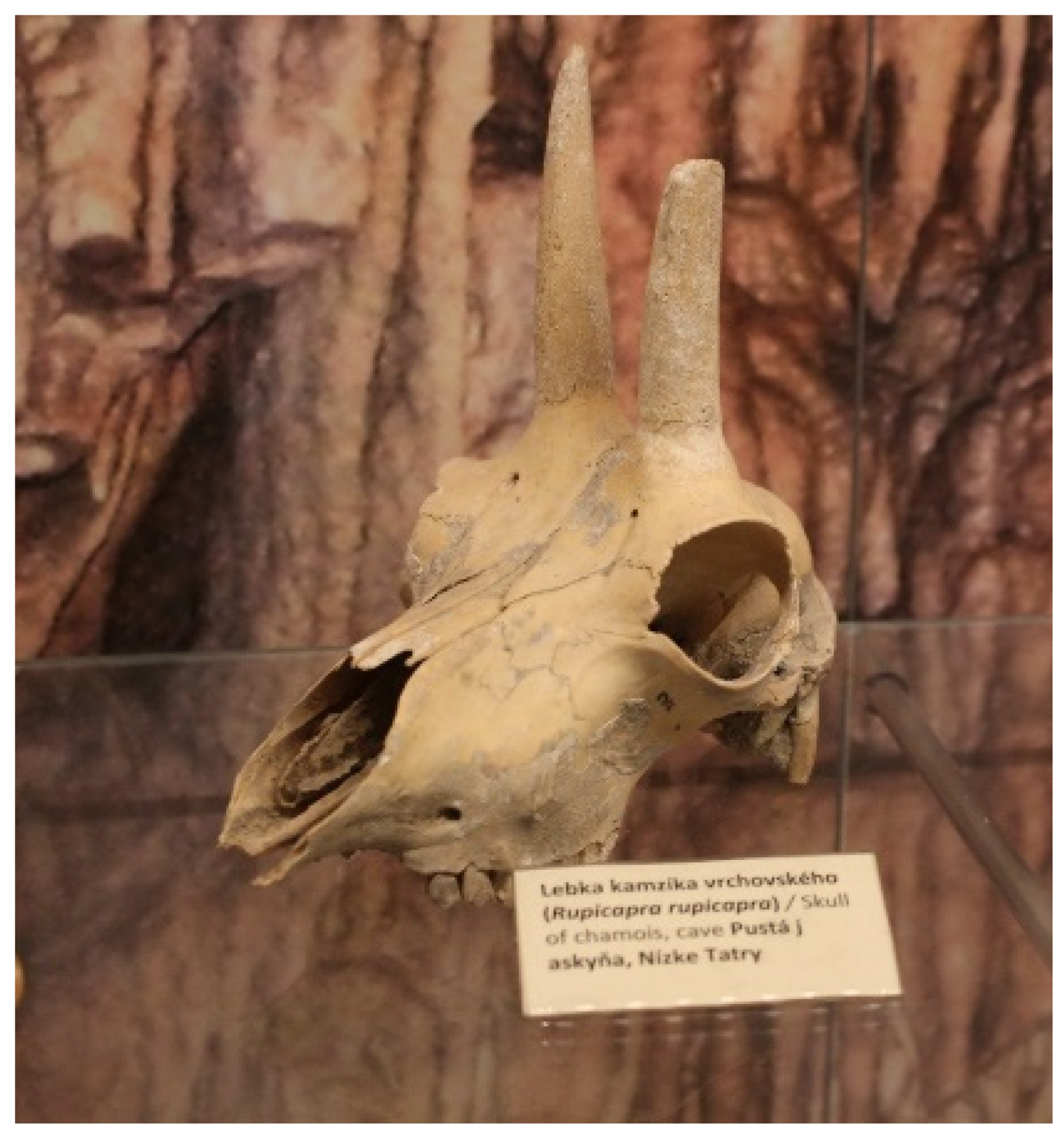
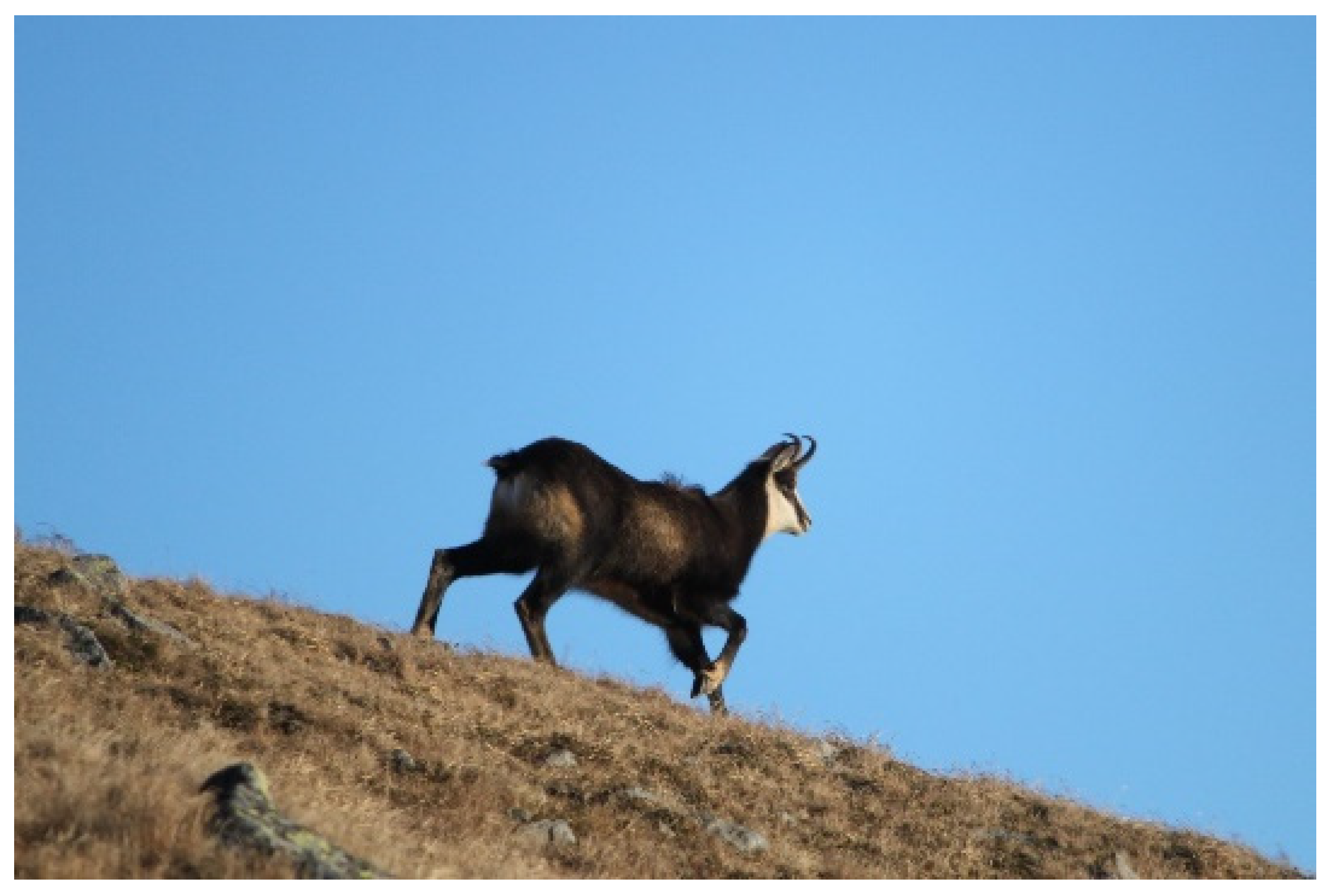
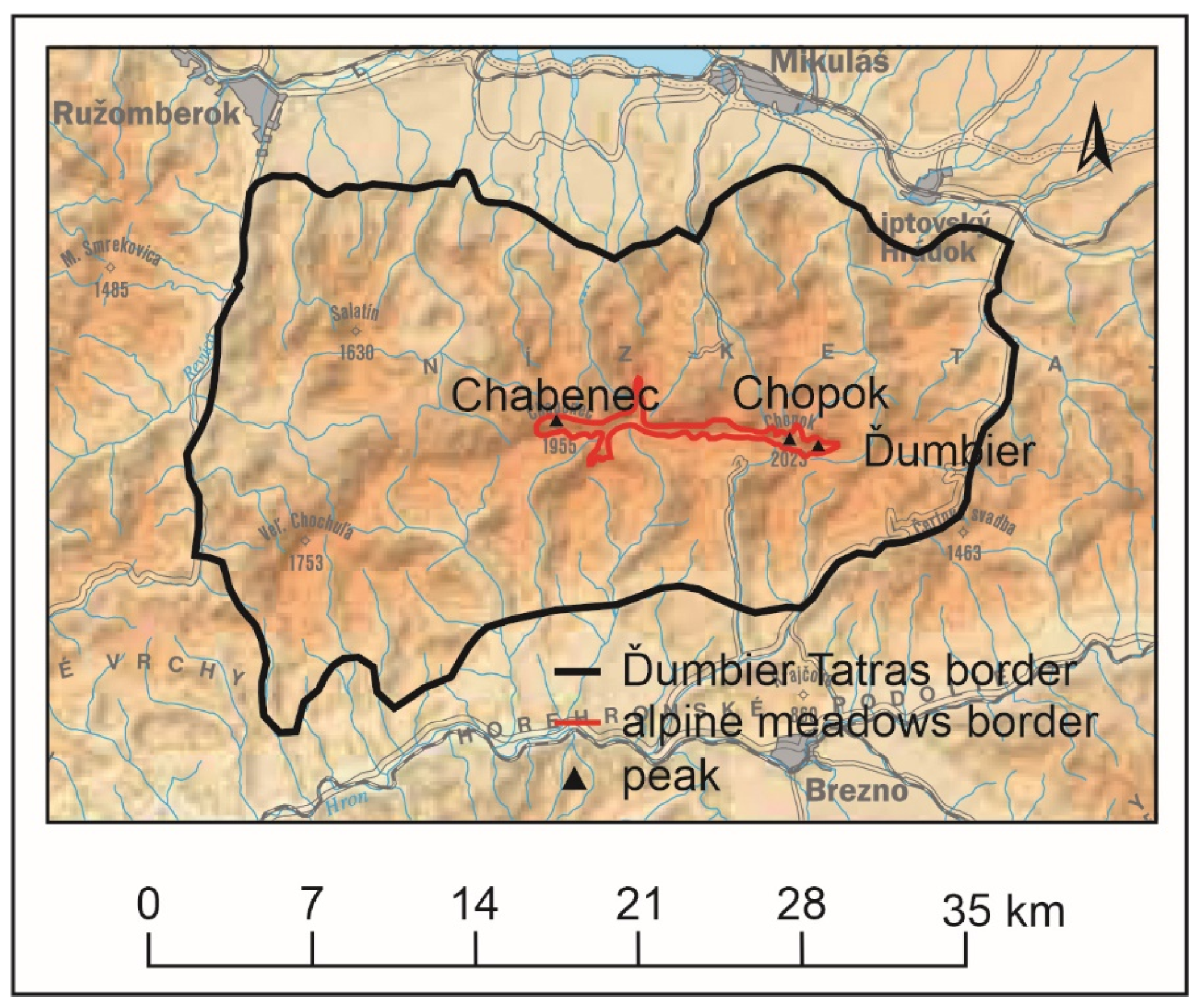
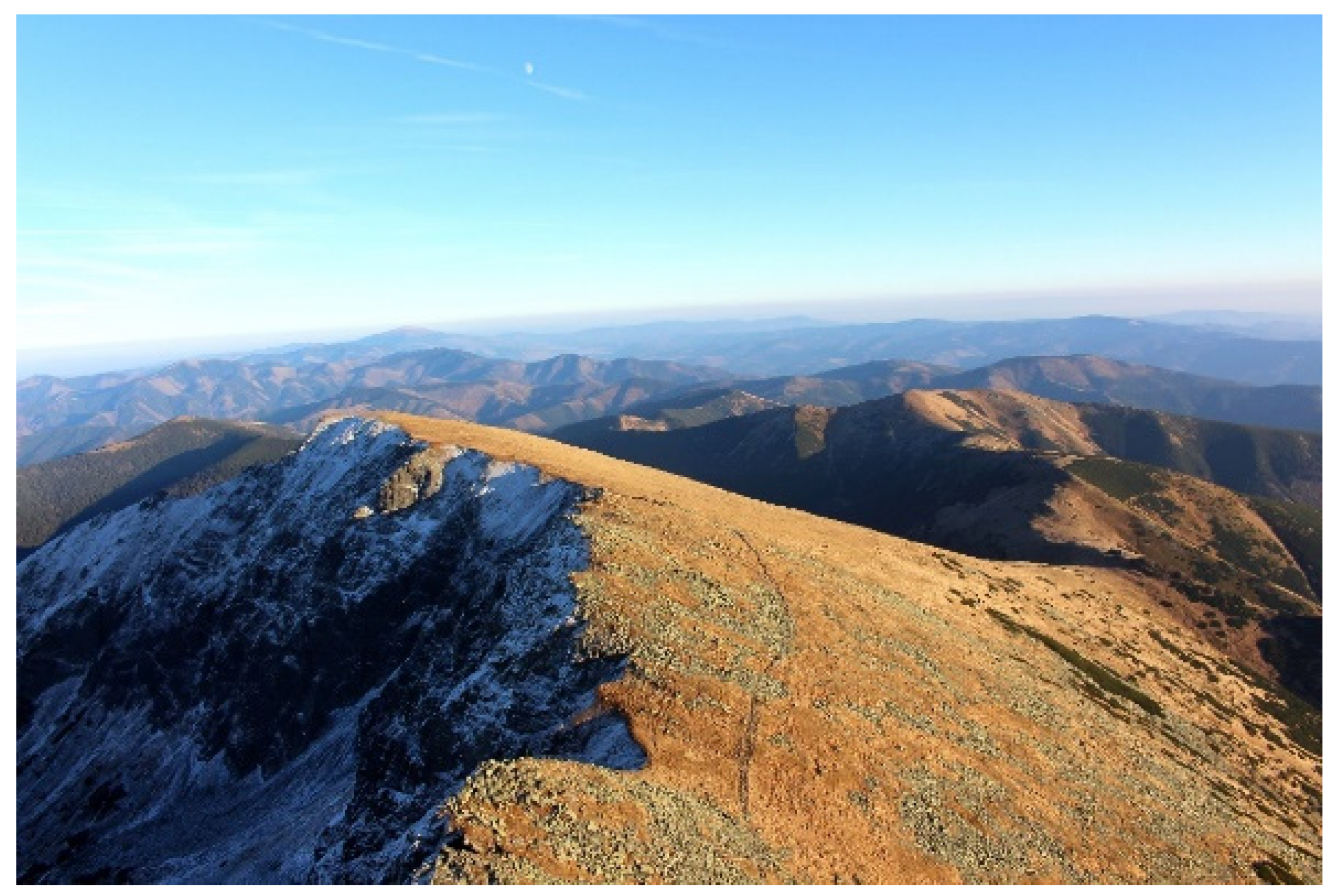
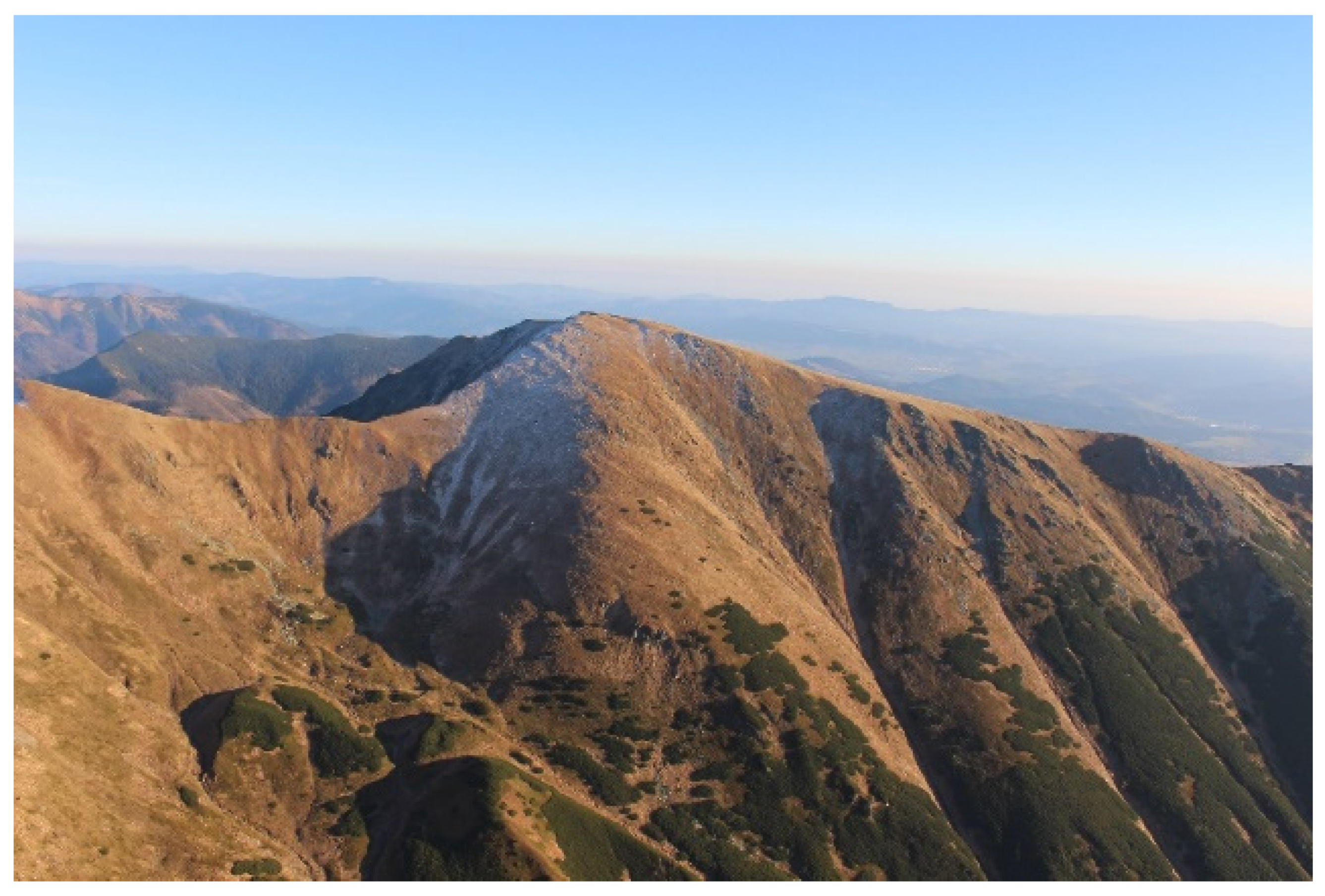





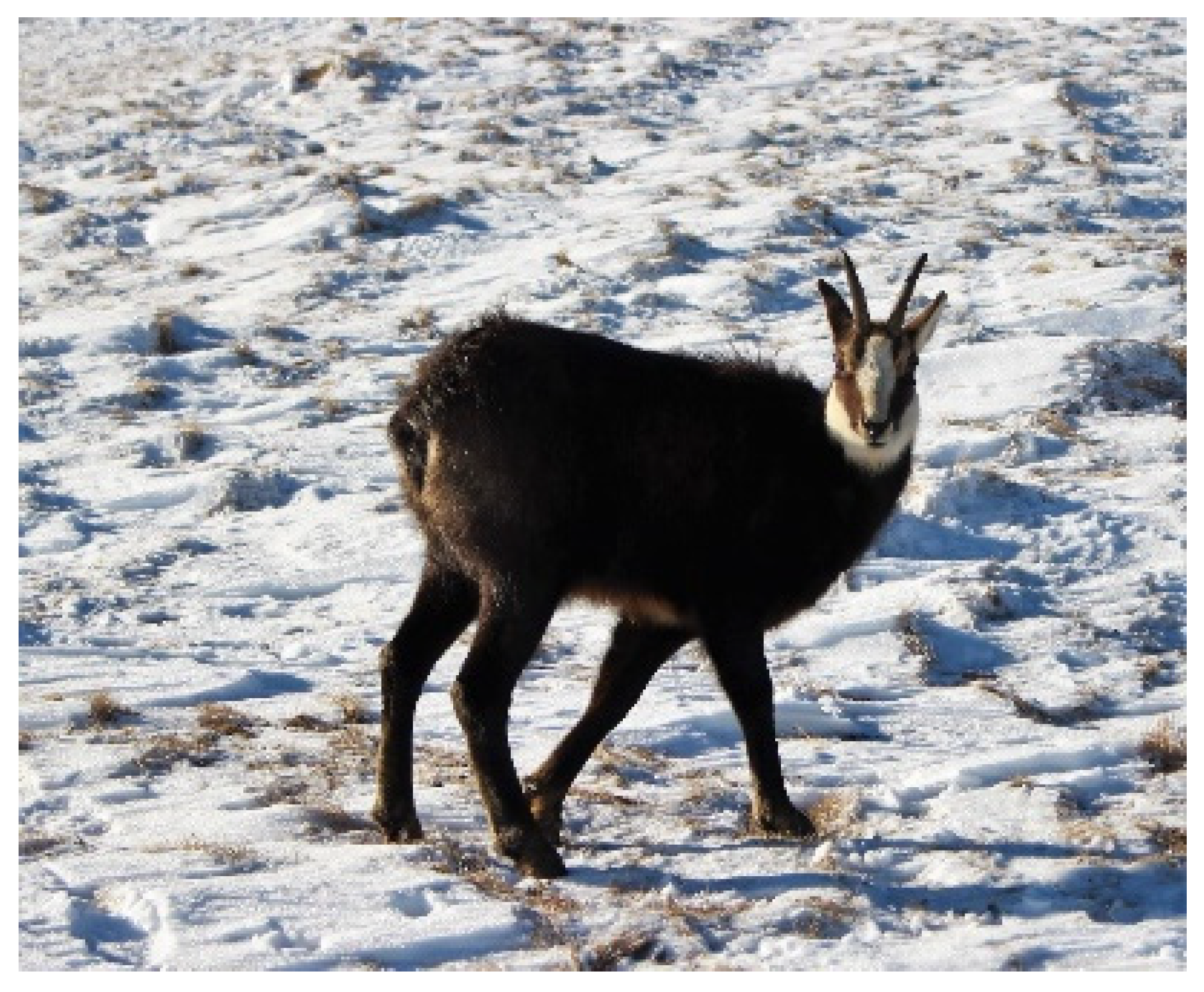
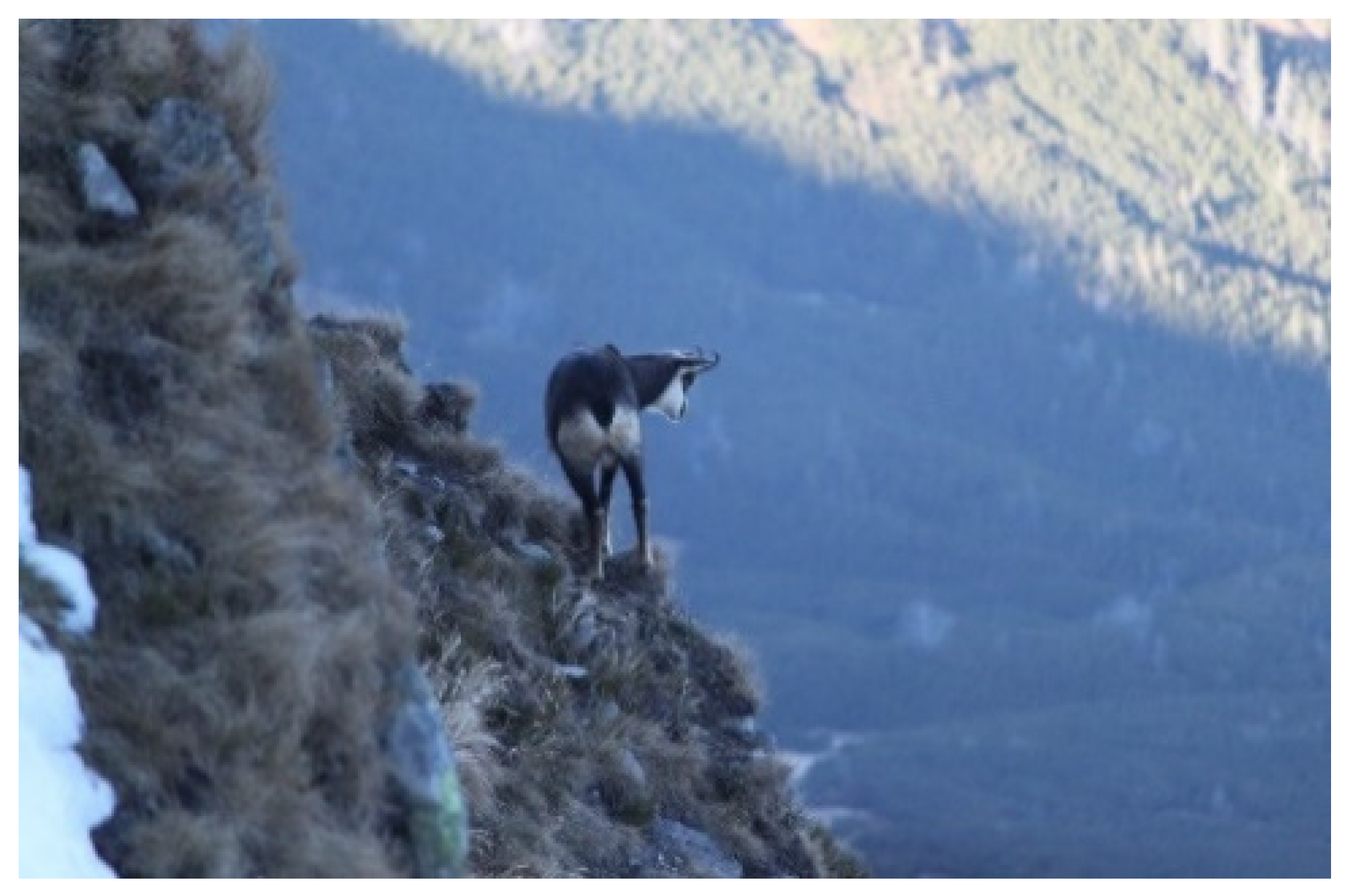
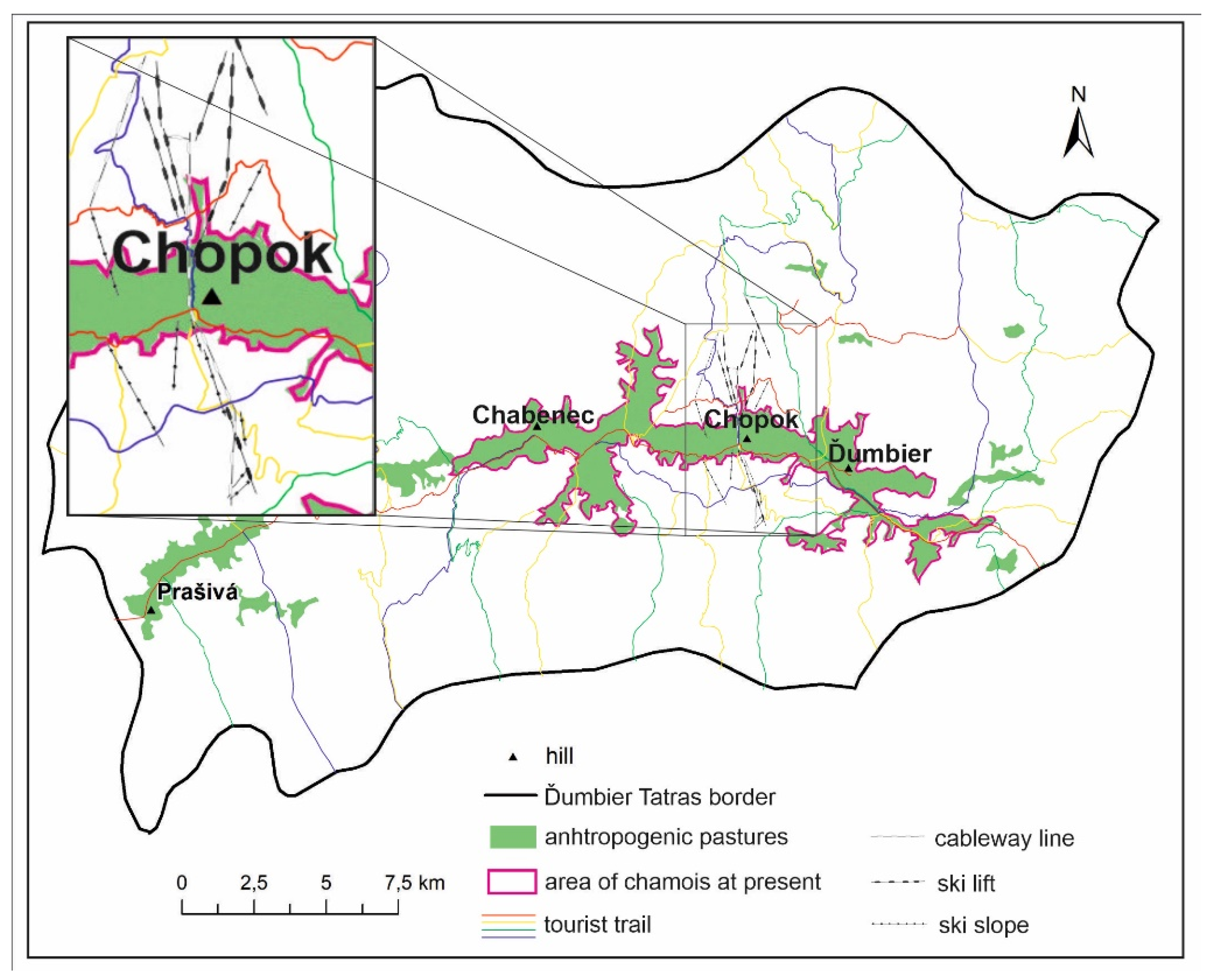
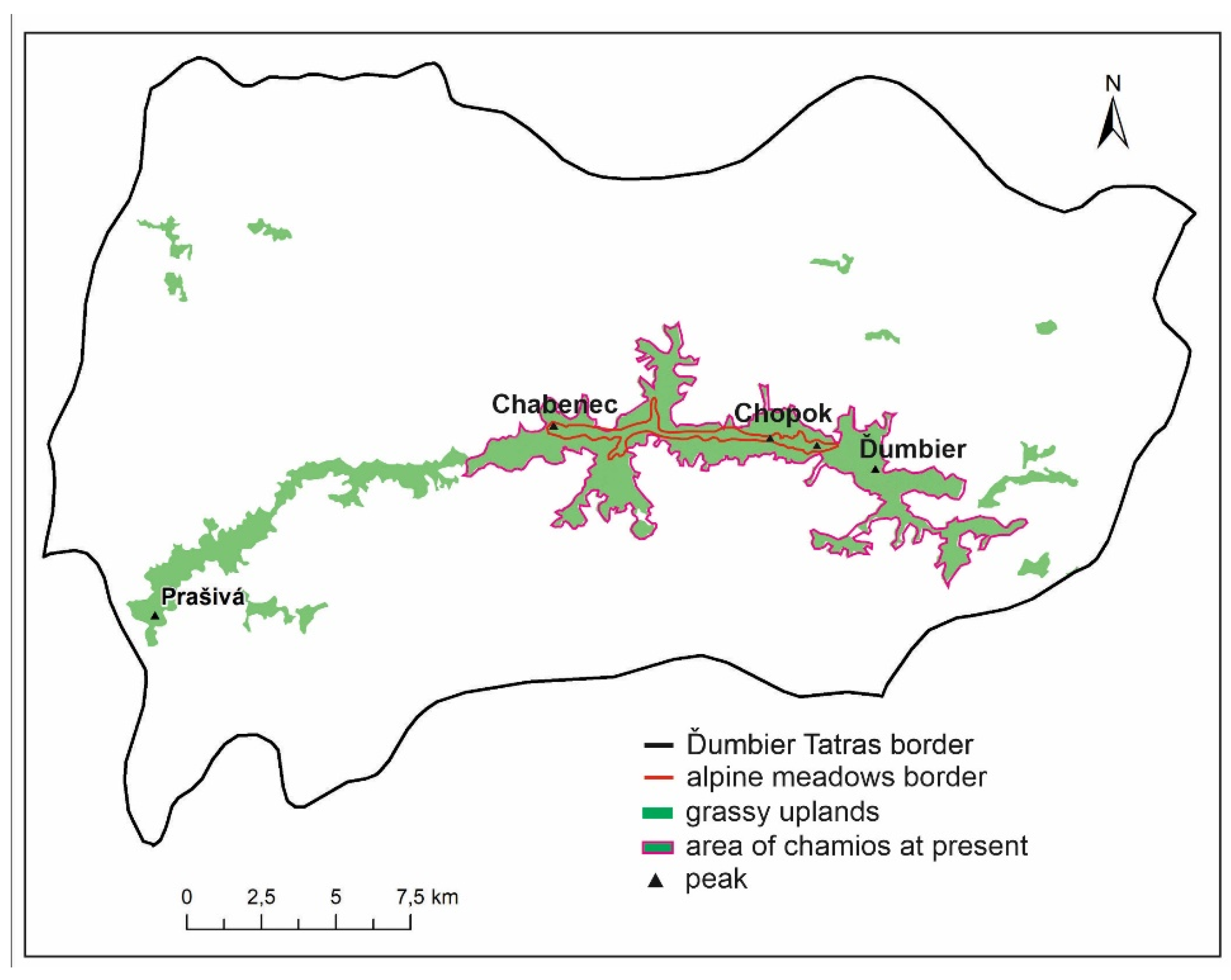
Publisher’s Note: MDPI stays neutral with regard to jurisdictional claims in published maps and institutional affiliations. |
© 2022 by the authors. Licensee MDPI, Basel, Switzerland. This article is an open access article distributed under the terms and conditions of the Creative Commons Attribution (CC BY) license (https://creativecommons.org/licenses/by/4.0/).
Share and Cite
Hronček, P.; Urban, P.; Gregorová, B.; Čech, V.; Tometzová, D. Anthropogenically Created Alpine Pastures as Landscape Resources for the Alpine Chamois Population in the Western Carpathians Mountain Range: Ďumbier Tatras Case Study. Land 2022, 11, 2177. https://doi.org/10.3390/land11122177
Hronček P, Urban P, Gregorová B, Čech V, Tometzová D. Anthropogenically Created Alpine Pastures as Landscape Resources for the Alpine Chamois Population in the Western Carpathians Mountain Range: Ďumbier Tatras Case Study. Land. 2022; 11(12):2177. https://doi.org/10.3390/land11122177
Chicago/Turabian StyleHronček, Pavel, Peter Urban, Bohuslava Gregorová, Vladimír Čech, and Dana Tometzová. 2022. "Anthropogenically Created Alpine Pastures as Landscape Resources for the Alpine Chamois Population in the Western Carpathians Mountain Range: Ďumbier Tatras Case Study" Land 11, no. 12: 2177. https://doi.org/10.3390/land11122177
APA StyleHronček, P., Urban, P., Gregorová, B., Čech, V., & Tometzová, D. (2022). Anthropogenically Created Alpine Pastures as Landscape Resources for the Alpine Chamois Population in the Western Carpathians Mountain Range: Ďumbier Tatras Case Study. Land, 11(12), 2177. https://doi.org/10.3390/land11122177






